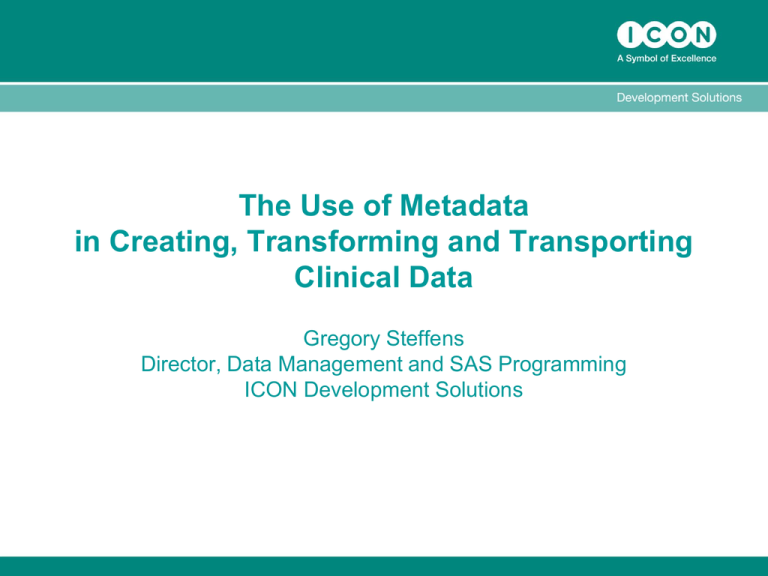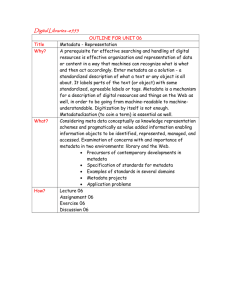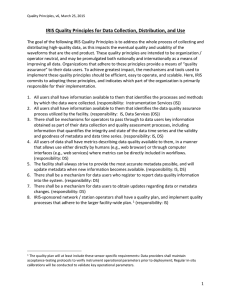The Use of Metadata in Creating, Transforming and Transporting Clinical Data Gregory Steffens
advertisement

The Use of Metadata in Creating, Transforming and Transporting Clinical Data Gregory Steffens Director, Data Management and SAS Programming ICON Development Solutions Data Flow Constituents • Data flow is comprised of transformation and derivation – Transformation – restructures, re-attributes and integrates – Derivation – creates new values in a target database that do not exist in the source Data Transformations • Data transformations comprise a large portion of what we do – Extract from data collection/cleaning applications to a standard – Integrate ancillary data like lab, randomization, QOL, etc. – Creation of analysis database – Integrate multiple studies into an integrated database The DTE • Therefore, there is a need to define, create, validate and describe databases efficiently and with a consistently high level of quality • A combination of reusable code driven by standardized metadata is the answer – the Data Transformation Engine (DTE) • The code must not make any assumptions of the source and target databases, this is communicated to the code via metadata • The metadata structures must be absolutely standardized across all applications and data standards • Metadata is populated prescriptively and drives the data flow Metadata Constituents • A standard list of attributes to include in any description of a database or of a data standard • Put in a standard set of data structures that can be read by the DTE code • The attributes must be highly structured in order to be usable by DTE code Standard Database Attributes • Data Set Level – Short/long names, data set location, order • Variable level – Short/long name, type, length label, primary key flag, format, value list name, suppqual flag, code/decode relationship, order, • Valid values – Value list name, start/end value, short decode, long decode • Descriptions – Source name, derivation description • Row-level attributes – Identical to variable level attributes but for subsets of rows defined by a parameter variable value Row-Level Metadata • Necessary to fully describe tall-thin data set structures USUBJID SYSBP BPSYSLOC BPSYSU HEIGHT HEIGHTU WEIGHT WEIGHTU BMI BMIU 1 120 STANDING mm Mg 185 CM 90 KG 26.3 Kg/m**2 USUBJID 1 1 1 1 VSTESTCD SYSBP HEIGHT WEIGHT BMI VSLOC STANDING VSORRES 120 185 90 26.3 VSORRESU Mm Mg CM KG Kg/M**2 Metadata Structure • Structured content to enable programmatic access • Storage structure is separate from publication structure – maximize programmatic access and user friendly access by people • Also separate from entry format • Maximize sharing of information within the metadata, e.g. values lists and descriptions Some Principles of Metadata Design • Rigorously standardized for all database and standard descriptions, no metadata design change for database types! • Maximize structured information and programmatic access, e.g. primary keys flagged instead of listed • Enter once; use many. e.g. descriptions and values • Derivation logic in descriptions though Objectives of Metadata • It is critical to explicitly define the objectives. Many disagreements arise from an unstated difference in assumed objectives • Objectives allow evaluation of the success of the metadata design; e.g. retrospective description for esubmission or prescriptive enabler of automation. Objectives … • Single metadata design for everything • Minimize duplicate entry • Include enough attributes to enable automation • Separate metadata design from publication and from entry • Generalize SAS macros, don’t specialize for any specific database standard Some Automation that is Enabled • Creating study data requirements from data standards • Publish data requirements in several formats – pdf, xml, html, etc. • Publish data requirements with different levels of detail for different user types • Implement all database attributes from the requirements with one macro call • Create version 5 transport files with renames and length changes of names and labels • Create integrated databases • Create all decode variables with one macro call More Automation Examples • Move variables in and out of suppqual domains • Validate that a database follows a standard and a study requirement • Compare a new data requirement to a standard or other studies • Create 0-obs data sets • Automate TFL shells • Transform databases from any structure to any other structure … but what else do we need to do that? Map Metadata The Next Kind of Metadata • So far, we have metadata that describes databases • The next step is standard map metadata to define transformation types from one database to another • Map metadata associates one observation of source metadata with one or more observations of target metadata • This mapping information is read by SAS macros that generate all the SAS code to create a target database from a source database • Map metadata should be separate but integrated with metadata The DTE Code Examples • %dtmap – (source_mdlib=m,source_prefix=raw_,target_mdlib=m,target_prefix =target_,maplib=me,inlib=raw,outlib=sdtm,suppqual_make=yes) • %mdprint – (mdlib=m,inprefix=target_,html=yes,htmlfile=c:\metadata\target_defi ne.html) • %md2odm – (mdlib=m,outxml=c:\metadata\SDTM.xml,StudyName=ICR_STDM_ Standard 3.1.2,ProtocolName=SDTM,StandardName=SDTM 3.1.2,StudyDescription=SDTM Standard,defineVersion=1.0.0,odmversion=1.2,crt_prefix=def) Advantages of the DTE • Standards are a means to automation and automation is a means to efficiency and quality • Much less code invented and validated for individual studies • Change in skill set requirements for data flow – separate coding skills from database and clinical skills • More productivity from junior staff • Faster, better and cheaper.




